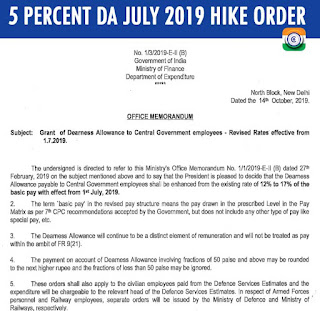7th Pay Commission Report: General Provident Fund (GPF) for Central Government employees
 9.4.1 General Provident Fund (GPF) for Central Government employees was started w.e.f. 1 April, 1960. It covers those government employees who joined service before 01.01.2004 and are not governed by the Contributory Provident Fund Scheme. The scheme was introduced to foster the habit of saving amongst government employees and to provide them financial help in times of need. The Commission has not received any demands regarding modifications in this scheme.
9.4.1 General Provident Fund (GPF) for Central Government employees was started w.e.f. 1 April, 1960. It covers those government employees who joined service before 01.01.2004 and are not governed by the Contributory Provident Fund Scheme. The scheme was introduced to foster the habit of saving amongst government employees and to provide them financial help in times of need. The Commission has not received any demands regarding modifications in this scheme.
Analysis and Recommendations
9.4.2 The Commission has analyzed the views of the previous Pay Commissions regarding GPF. The IV CPC and the V CPC did not favour making the scheme optional on the grounds that the fund provided relief to employees in times of need and that accretions to the fund also improved the government’s ways and means position. The VI CPC had, however, recommended that the “future investments in GPF should be allowed purely on voluntary basis with no minimum being prescribed.” Their rationale was that the resource position of Central Government is comfortable and the revenues are showing a steady growth, employees have the option of a variety of market instruments to choose from for investment purposes, and with the proposed increase in monthly subscription under the CGEGIS (70% of which is for saving purposes), the government employees will, in any case, be making a much higher saving.
9.4.3 The Commission notes that the recommendations of the VI CPC regarding CGEGIS and GPF were not accepted by the government; neither the CGEGIS rates were revised, nor GPF was made voluntary.
9.4.4 This Commission is of the view that, with the introduction of NPS w.e.f. 01.01.2004, the number of subscribers under the GPF scheme will decrease as time goes by. Moreover, the scheme has worked well over the past 65 years and has provided pecuniary relief to the subscribers in times of need. Accordingly the Commission does not find merit in any disturbance at this point of time. Hence, status quo is recommended.

Analysis and Recommendations
9.4.2 The Commission has analyzed the views of the previous Pay Commissions regarding GPF. The IV CPC and the V CPC did not favour making the scheme optional on the grounds that the fund provided relief to employees in times of need and that accretions to the fund also improved the government’s ways and means position. The VI CPC had, however, recommended that the “future investments in GPF should be allowed purely on voluntary basis with no minimum being prescribed.” Their rationale was that the resource position of Central Government is comfortable and the revenues are showing a steady growth, employees have the option of a variety of market instruments to choose from for investment purposes, and with the proposed increase in monthly subscription under the CGEGIS (70% of which is for saving purposes), the government employees will, in any case, be making a much higher saving.
9.4.3 The Commission notes that the recommendations of the VI CPC regarding CGEGIS and GPF were not accepted by the government; neither the CGEGIS rates were revised, nor GPF was made voluntary.
9.4.4 This Commission is of the view that, with the introduction of NPS w.e.f. 01.01.2004, the number of subscribers under the GPF scheme will decrease as time goes by. Moreover, the scheme has worked well over the past 65 years and has provided pecuniary relief to the subscribers in times of need. Accordingly the Commission does not find merit in any disturbance at this point of time. Hence, status quo is recommended.











0 comments:
Post a Comment